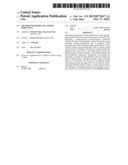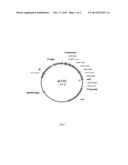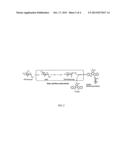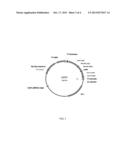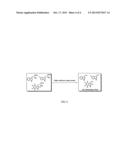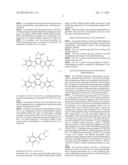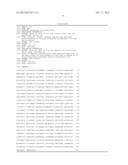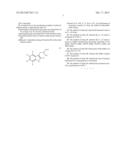Patent application title: METHOD FOR PRODUCING INDOLE DERIVATIVE
Inventors:
Hsien-Tai Chiu (Hsinchu, TW)
IPC8 Class: AC12P1710FI
USPC Class:
435121
Class name: Micro-organism, tissue cell culture or enzyme using process to synthesize a desired chemical compound or composition preparing heterocyclic carbon compound having only o, n, s, se, or te as ring hetero atoms nitrogen as only ring hetero atom
Publication date: 2013-10-17
Patent application number: 20130273617
Abstract:
The present invention provides a method for in vitro producing an indole
derivative in a one-pot reaction. The method for producing a
rhamnosylated indolocarbazole compound includes the steps of transforming
a plasmid carrying a gene encoding N-glycosyltransferase into a bacterial
strain; expressing the gene encoding N-glycosyltransferase in the
bacterial strain; lysing the bacterial strain to obtain a crude enzyme
extract; and adding TDP-glucose, an indolocarbazole aglycone and a metal
ion in the crude enzyme extract for performing an enzymatic reaction to
form the rhamnosylated indolocarbazole compound. Alternatively, the
method for producing an indole-3-carboxaldehyde analog includes the steps
of transforming a plasmid carrying a gene encoding NokA of Nocardiopsis
sp. K-252 into a bacterial strain; expressing the gene encoding NokA in
the bacterial strain; lysing the bacterial strain to obtain a crude
enzyme extract; and adding an L-tryptophan analog for performing an
enzymatic reaction to form the indole-3-carboxaldehyde analog.Claims:
1-11. (canceled)
12. A method for in vitro producing an indole-3-carboxaldehyde analog, comprising the steps of: transforming a plasmid carrying a gene encoding NokA of Nocardiopsis sp. K-252 into a bacterial strain; expressing the gene encoding NokA in the bacterial strain; lysing the bacterial strain to obtain a crude enzyme extract; and adding an L-tryptophan analog of formula (III) in the crude enzyme extract ##STR00006## wherein R=H, OH, F, Cl, Br or CH3, for performing an enzymatic reaction to form the indole-3-carboxaldehyde analog.
13. The method of claim 12, wherein the bacterial strain is an E. coli strain.
14. The method of claim 13, wherein the E. coli strain is incubated at 25-40.degree. C.
15. The method of claim 13, wherein the E. coli strain is lysed in a buffer selected from the group consisting of Tris buffer, HEPES buffer, MOPS buffer, K2HPO4 buffer and MES buffer.
16. The method of claim 15, wherein pH of the buffer is in a range from 5 to 10.
17. The method of claim 15, wherein the buffer contains 0-25% of glycerol.
18. The method of claim 12, wherein the step of lysing is performed by a homogenizer or sonication.
19. The method of claim 12, wherein the enzymatic reaction is performed at 4-40.degree. C.
Description:
BACKGROUND OF THE INVENTION
[0001] 1. Field of the Invention
[0002] The present invention relates to methods for producing an indole derivative, and more particularly to a method for producing a rhamnosylated indolocarbazole compound or an indole-3-carboxaldehyde analog.
[0003] 2. Description of Related Art
[0004] The family of indolocarbazole natural products has been a valuable source of lead compounds with potential therapeutic applications in the treatment of cancer and neurodegenerative disorders. In the indolocarbazole family, lestaurtinib has been approved by FDA for treating acute leukemia, CEP-1347 has entered the phase III clinical trial for treating Parkinson's disease, and K-252a, K-252b and staurosporine display anticancer activities. In addition, it is known that K-252d, rhamnosyl-K252c, is capable of inhibiting activity of protein kinase C (PKC). The PKC family plays an important role in cellular proliferation and signal transduction. Hence, specific inhibitors against PKC are promising antitumor drugs for cancer chemotherapy.
[0005] S. Nakanishi et al. disclosed the extraction of K-252d from incubation medium of a microorganism. (J. Antibiot., 1986, 39, 1066-1071) However, such extraction needs three purification steps to obtain only 13.3 mg of K-252d from 8.4 L culture medium.
[0006] The synthesis of K-252d is summarized in the following Scheme I.
##STR00001##
[0007] As shown in Scheme I, synthesis of TDP-rhamnose is accomplished by tandem enzymatic conversion of TDP-glucose with NDP-glucose 4,6-dehydratase (Gdh), NDP-4-keto-6-deoxyglucose epimerase (Epi) and NDP-4-ketorhamnose reductase (Kre). Then, TDP-rhamnose is linked to K-252c by N-glycosyltransferase to form K-252d.
[0008] Chen et al. disclosed in vitro biosynthesis of TDP-rhamnose. (J. Biol. Chem., 2009, 284, 7352-7363) However, this method needs to purify three enzymes, Gdh, Epi and Kre, and several processing steps.
[0009] In addition, it is known that indole-3-carboxaldehyde (ICA) has anti-bacterial activity to gram positive bacteria such as S. aureus or to gram negative bacteria such as E. coli or E. faecium. Further, ICA can be modified for treating stroke, cancer or neurodegeneration disease such as Parkinson's disease. A modified ICA, 3-ICA-TSC, is an amebacide.
[0010] However, it is very complicated to purify ICA from a microorganism. (Nat. Prod. Res., 2005, 19, 645-652) S. S. Panda et al. disclosed chemical synthesis of ICA, which may cause environmental problems due to usage of organic solvents and toxic agents. (Indian J. Pharm. Sci., 2008, 70, 208-215)
[0011] Therefore, in order to overcome the drawbacks of the conventional methods, the present invention provide a novel method for in vitro simply and efficiently producing an indole derivative.
SUMMARY OF THE INVENTION
[0012] The present invention provides a novel method for in vitro producing a rhamnosylated indolocarbazole compound. The method includes the steps of: transforming a plasmid carrying a gene encoding N-glycosyltransferase into a bacterial strain; expressing the gene encoding N-glycosyltransferase in the bacterial strain; lysing the bacterial strain to obtain a crude enzyme extract; and adding TDP-glucose, an indolocarbazole aglycone and a metal ion in the crude enzyme extract for performing an enzymatic reaction to form the rhamnosylated indolocarbazole compound.
[0013] Preferably, the bacterial strain is an E. coli strain, which is preferably incubated at 25-40° C.
[0014] Preferably, the N-glycosyltransferase is NokL of Nocardiopsis sp. K-252.
[0015] In accordance with the present invention, the step of lysing is performed by a homogenizer (e.g. French press) or sonication.
[0016] In accordance with the present invention, the bacterial strain is lysed in a buffer selected from the group consisting of Tris buffer, HEPES buffer, MOPS buffer, K2HPO4 buffer and MES buffer. Preferably, pH of the buffer is in a range from 5 to 10, and the buffer contains 0-25% of glycerol.
[0017] In accordance with the present invention, the indolocarbazole aglycone is a compound of formula (I) or a compound of formula (II), or its analog
##STR00002##
in which R=H, OH, F, Cl, Br or CH3, and wherein the rhamnosylated indolocarbazole compound is K-252d (or its analogs).
[0018] In accordance with the present invention, the metal ion is a magnesium ion or a manganese ion, and the enzymatic reaction is performed at 4-40° C.
[0019] In addition, the present invention provides a method for in vitro producing an indole-3-carboxaldehyde analog. The method includes the steps of: transfouning a plasmid carrying a gene encoding NokA of Nocardiopsis sp. K-252 into an E. coli strain; expressing the gene encoding NokA in the E. coli strain; lysing the E. coli strain to obtain a crude enzyme extract; and adding an L-tryptophan analog of formula (III)
##STR00003##
wherein R=H, OH, F, Cl, Br or CH3. Preferably, the E. coli strain is lysed in a buffer selected from the group consisting of Tris buffer, HEPES buffer, MOPS buffer, K2HPO4 buffer and MES buffer, wherein pH of the buffer is in a range from 5 to 10, and the buffer contains 0-25% of glycerol.
[0020] In the following section preferred embodiments are described. However, this is not intended in any way to limit the scope of the present invention.
BRIEF DESCRIPTION OF THE DRAWINGS
[0021] The present invention can be more fully understood by reading the following detailed description of the preferred embodiments, with reference made to the accompanying drawings, wherein:
[0022] FIG. 1 is a construct map of pCY16 according to the present invention;
[0023] FIG. 2 is a scheme showing synthesis of K-252d according the embodiment of the present invention;
[0024] FIG. 3 is a construct map of pJZ22 according to the present invention; and
[0025] FIG. 4 is a scheme showing synthesis of indole-3-carboxaldehyde analogs according the embodiment of the present invention;
DETAILED DESCRIPTION OF PREFERRED EMBODIMENTS
[0026] The following illustrative embodiments are provided to illustrate the disclosure of the present invention, these advantages and effects can be apparently understood by those in the art after reading the disclosure of this specification. The present invention can also be performed or applied by other different embodiments. The details of the specification may be on the basis of different points and applications, and numerous modifications and variations can be devised without departing from the spirit of the present invention.
[0027] It is known that Nocardiopsis sp. K-252 (Nonomuraea longicatena K252T, NRRL15532) produces indolocarbazole alkaloids of antitumor antibiotics. Thus, the inventors constructed a fosmid genomic DNA library of Nocardiopsis sp. K-252 by using a CopyControl fosmid library production kit (Epicentre). As a result, the genomic library was constructed with a total of 5856 fosmid clones, whereas the average sizes of genomic DNA fragments were ca. 35 kb per clone. A 45 kb sequence contig was subsequently obtained by DNA sequencing to cover the entire gene cluster for the biosynthesis of the indolocarbazole compounds, K-252a and its analogs, in Nocardiopsis sp. K-252. The DNA sequence of nok genes responsible for biosynthesis of K-252a was deposited in GenBank under accession number FJ031030. Sequence analysis of the 45 kb genomic sequence revealed 35 open reading frames. The inventors identified the gene nokL (SEQ ID NO: 1; GenBank accession number: ACN29718) encoding N-glycosyltransferase, and the gene nokA (SEQ ID NO: 2; GenBank accession number: ACN29719) encoding L-amino acid oxidase. The detailed description about molecular cloning, sequence analysis and functional characterization of the gene cluster for biosynthesis of K-252a and its analogs has been published on Mol. BioSyst., 2009, 5, 1180-1191, which is entirely incorporated herein by reference.
[0028] The present invention provides a heterologous expression system of Escherichia coli containing indolocarbazole N-glycosyltransferase for in vitro producing molecules exhibiting potent neuroprotective or broad anticancer activities in a one-pot reaction.
[0029] In the present invention, the plasmid containing the DNA encoding N-glycosyltransferase is transformed into an E. coli strain, which is then incubated until OD600 being 0.3-0.7. Preferably, the N-glycosyltransferase is NokL of Nocardiopsis sp. K-252. After adding an inducing agent, the bacterial culture is further incubated at a 25-40quadrature. Then, the culture pellet is collected and further re-suspended in a buffer solution to be lyzed by a homogenizer (e.g. French press) or sonication, such that the crude enzyme extract is obtained. Preferably, the buffer solution is Tris, HEPES, MOPS, K2HPO4 or MES, the pH value of the buffer solution is in the range from 5 to 10, and the glycerol concentration of the buffer solution is 0-25%.
[0030] Subsequently, the crude enzyme extract is mixed with TDP-glucose, indolocarbazole aglycone, K-252c or its analog, and metal ions. The indolocarbazole aglycone is the compound of formula (I) or the compound of formula (II), in which R=H, OH, F, Cl, Br or CH3. The metal ions are magnesium ions or manganese ions. The enzymatic biosynthesis is performed at 4-40° C.
##STR00004##
[0031] In addition, the present invention provides a method for in vitro producing ICA and its analogs in a one-pot reaction. In the present invention, the plasmid containing the DNA encoding L-amino acid oxidase is transformed into an E. coli strain, which is then incubated until (OD600 being 0.3-0.7. Preferably, the L-amino acid oxidase is NokA of Nocardiopsis sp. K-252. After adding an inducing agent, the bacterial culture is further incubated at a 25-40° C. Then, the culture pellet is collected and further re-suspended in a buffer solution to be lyzed by a homogenizer (e.g. French press) or sonication, such that the crude enzyme extract is obtained. Preferably, the buffer solution is Tris, HEPES, MOPS, K2HPO4 or MES, the pH value of the buffer solution is in the range from 5 to 10, and the glycerol concentration of the buffer solution is 0-25%.
[0032] Subsequently, the crude enzyme extract is mixed with an L-tryptophan analog of formula (III), wherein R=H, OH, F, Cl, Br or CH3. The enzymatic biosynthesis is performed at 4-40quadrature.
##STR00005##
[0033] Biochemical characterization and substrate specificity of the gene cluster for biosynthesis of K-252a and its analogs by in vitro heterologous expression system of Escherichia coli has been published on Mol. BioSyst., 2009, 5, 1192-1203, which is entirely incorporated herein by reference.
[0034] Embodiment of In Vitro Biosynthesis of K252d:
[0035] Construction of the NokL Expression Plasmid
[0036] FIG. 1 shows the construct map of pCY16. The gene nokL (SEQ ID NO: 1) of Nocardiopsis sp. K-252 was amplified on pJC3B5 by PCR with a forward primer with an NdeI site and a reverse primer with a stop codon (TGA) followed by an EcoRI site near 5'-end. The amplified PCR product was ligated with blunt-ended pUC19 (NEB) at SmaI to generate pCY15. After digestion of pCY15 with NdeI and EcoRI, the digestion fragment carrying nokL was cloned into pET21b vector to give pCY16 for the wild-type NokL expression experiments. For plasmid construction of N-terminal His6-tagged NokL, the same digestion fragment was cloned into pET28a to afford pCY17. For C-terminal His6-tagged NokL expression, the nokL gene was amplified on pCY16 by PCR with primer pairs of NKLNdF1 (forward, with NdeI) and NKLXR1 (reverse, with XhoI). The resulting PCR product was subsequently cloned into pET21b at the corresponding sites to yield pMS4.
[0037] Preparation of the NokL Cell-Free Crude Extract
[0038] The pCY16 (NokL) and pG-KJE7 (chaperones) plasmids were co-transformed into E. coli BL21 (DE3). Cells were grown at 37° C. in LB medium with antibiotics (100 μg/ml ampicillin and 30 μg/ml kanamycin) until OD600 reached 0.5. After induction with 0.1% (w/v) L-arabinose and 1 mM IPTG, the culture was allowed to grow at 30° C. for additional 20 hours. All procedures for the preparation of cell-free crude extract were carried out on ice or at 4° C. The cells were harvested by centrifugation (3200 g, 15 min), followed by resuspension with potassium phosphate buffer (20 mM K2HPO4, pH 7.8, 15% glycerol). Cells were broken and disrupted by two passages through a French press cell (Spectronic Instruments) at 16 000 psi. After removal of cell debris by centrifugation at 16000 g for 20 min, the desired crude NokL enzyme extract was obtained for the following enzymatic reaction.
[0039] Production of K-252d from Cell-Free Enzymatic Reaction
[0040] The crude NokL enzyme extract (1 mL, 20 mM K2HPO4 at pH 7.8, 15% glycerol) was mixed with TDP-glucose (1.5 mM, 1 mL, 12 mM Tris-HCl, pH7.6, 9% glycerol), K-252c (1.27 mM, 1 mL, 50% DMSO), MgCl2 (12 mM, 1 mL in H2O), and then the pH of the mixture was adjusted to 9.0 (12 mM MgCl2, 50 mM K2HPO4). The reaction of the mixture was performed at 30° C. for 24 hours.
[0041] Identification of NokL Enzymatic Product (K252d)
[0042] After the enzymatic reaction, the above reaction mixture was quenched by 5 ml of the ice-cold alcohol solution (MeOH-EtOH). The resulting mixture was subsequently subjected to centrifugation (16,000 g, 4° C.) for 2 hours to remove precipitated proteins. The supernatant was purified by semi-preparative RP-HPLC. Fractions containing K252d were pooled and evaporated to remove organic solvents, followed by extraction with ether. The ether layer containing K252d was evaporated to remove ether and then vacuumed to gain the K252d (2.0 mg). The purity of K252d was greater than 95% as judged by analytical RP-HPLC. The NMR spectrum of K252d dissolved in D4-methanol (CD3OD) was recorded at 500 MHz. For NMR analysis: 1H-NMR (CD3OD, 500 MHz) δH 1.80 (3H, d, J=7.0 Hz), 4.15 (1H, dd, J=4.0 Hz), 4.33 (1H, td, J=4.0 Hz), 4.55 (1H, m), 4.70 (1H, d, J=4.0 Hz) 5.05 (2H, d, J=4.0 Hz), 6.54 (1H, d, J=10.0 Hz), 7.26 (1H, t, J=7.0 Hz), 7.30 (1H, t, J=8.5 Hz), 7.45 (1H, t, J=8.0 Hz), 7.48 (1H, t, J=8.5 Hz), 7.61 (1H, d, J=8.5 Hz), 7.72 (1H, d, J=8.5 Hz), 8.02 (1H, d, J=8.5 Hz), 9.40 (1H, d, J=8.0 Hz) ppm. 13C-NMR (CD3OD, 125 MHz) δC 15.8, 47.0, 68.7, 73.3, 73.6, 78.5, 78.6, 110.5, 112.3, 116.5, 118.9, 119.7, 120.7, 121.0, 121.9, 123.6, 124.1, 126.2, 126.5, 126.8, 129.0, 129.7, 134.5, 141.0, 142.2, 175.8 ppm. For high resolution MALDI-TOF spectrometric analysis: C26H23N3O5 molecular weight calculated as 457.163, and found m/z of 457.177 [M].sup.+. Upon 1H-NMR, 13C-NMR and COSY, the rhamnosylated product was fully assigned with chemical shifts, in excellent agreement with those of K-252d reported by Yasuzawa (J. Antibiot., 1986, 39, 1072-1078).
[0043] As summarized in the scheme of FIG. 2, the present invention provides a novel method for in vitro producing K-252d in a one-pot reaction without purifying any enzyme. Furthermore, the method of the present invention can produce various indolocarbazole derivatives by using various indolocarbazole aglycones.
[0044] Embodiment of In Vitro Biosynthesis of Indole-3-Carboxaldehyde:
[0045] Construction of the NokA Expression Plasmid
[0046] FIG. 3 shows the construct map of pJZ22. The gene nokA (SEQ ID NO: 2) of Nocardiopsis sp. K-252 was amplified on pJC3B5 by PCR with a primer pair with NdeI and NheI sites at the 5' and 3' ends, respectively. The amplified PCR product preserving the stop codon was cloned into the NdeI and NheI sites of pET21b to generate pJZ22.
[0047] Preparation of the NokA Cell-Free Crude Extract
[0048] The pJZ22 (NokA) and pG-KJE7 (chaperones) plasmids were co-transformed into E. coli BL21 (DE3). Cells were grown at 37° C. in LB medium with antibiotics (100 μg/ml ampicillin and 30 μg/ml kanamycin) until OD600 reached 0.5. After induction with 0.2% (w/v) L-arabinose and 0.25 mM IPTG, the culture was allowed to grow at 30quadrature for additional 10 hours. All procedures for the preparation of cell-free crude extract were carried out on ice or at 4° C. The cells were harvested by centrifugation (1902 g, 20 min), followed by resuspension with the buffer (104 mM Tris-HCl, pH 7.6, 10% glycerol). Cells were broken and disrupted by sonication. After removal of cell debris by centrifugation at 15700 g for 20 min, the desired crude NokA enzyme extract was obtained for the following enzymatic reaction.
[0049] Production of Indole-3-Carboxaldehyde from Cell-Free Enzymatic Reaction
[0050] The crude NokA enzyme extract (80 μl, 80 mM Tris-HCl at pH 7.8, 7.6% (v/v) glycerol) was mixed with L-tryptophan (4 mM), and then incubated in a total volume of 104 μl at 30° C. for 24 hours.
[0051] Identification of NokA Enzymatic Product (Indole-3-Carboxaldehyde)
[0052] After the enzymatic reaction, the above reaction mixture was quenched by an equal volume of ice-cold MeOH, and was then subjected to reverse phase RP-HPLC analysis using by Agilent 1100 HPLC series equipped with quaternary pump and diode-array detector. As a result, RP-HPLC analysis of the NokA reaction revealed a major product peak and two minor ones. Upon characterization by NMR and mass spectroscopy, the major product was found to be indole-3-carboxaldehyde (ICA). 1H-NMR (CD3OD, 500 MHz), δH 7.170 (1H, ddd, J=1, 7.5 Hz), 7.212 (1H, ddd, J=1.5, 8 Hz), 7.410 (1H, d, J=8 Hz), 8.031 (1H, s), 8.091 (1H, d, J=8 Hz), and 9.822 (1H, s) ppm. 13C-NMR (CD3OD, 125 MHz), δC 113.122, 120.132, 122.384, 123.611, 124.998, 125.722, 138.940, 139.673, and 187.406 ppm.
[0053] As summarized in the scheme of FIG. 4, the present invention provides a novel method for in vitro producing ICA derivatives in a one-pot reaction without purifying any enzyme.
[0054] The invention has been described using the exemplary preferred embodiment. However, it is to be understood that the scope of the invention is not limited to the disclosed arrangements. The scope of the claims, therefore, should be accorded the broadest interpretation, so as to encompass all such modifications and similar arrangements.
Sequence CWU
1
SEQUENCE LISTING
<160> NUMBER OF SEQ ID NOS: 2
<210> SEQ ID NO 1
<211> LENGTH: 1314
<212> TYPE: DNA
<213> ORGANISM: Nonomuraea longicatena K252T
<220> FEATURE:
<221> NAME/KEY: gene encoding N-glycosyltransferase
<222> LOCATION: (1)..(1314)
<300> PUBLICATION INFORMATION:
<301> AUTHORS: Hsien-Tai Chiu, Yi-Lin Chen, Chien-Yu Chen, Chyn Jin,
Meng-Na Lee, Yu-Chin Lin
<302> TITLE: Molecular cloning, sequence analysis and functional
characterization of the gene cluster for biosynthesis of K-252a
and its analogs
<303> JOURNAL: Mol. BioSyst.
<304> VOLUME: 5
<306> PAGES: 1180-1191
<307> DATE: 2009-08-04
<308> DATABASE ACCESSION NUMBER: ACN29718
<309> DATABASE ENTRY DATE: 2009-10-06
<300> PUBLICATION INFORMATION:
<301> AUTHORS: Hsien-Tai Chiu, Yu-Chin Lin, Meng-Na Lee, Yi-Lin
Chen,
Mei-Sin Wang, Chia-Chun Lai
<302> TITLE: Biochemical characteriazation and susbstrate
specificity of
the gene cluster for biosynthesis of Escherichia coli
<303> JOURNAL: Mol. BioSyst.
<304> VOLUME: 5
<306> PAGES: 1192-1203
<307> DATE: 2009-08-04
<308> DATABASE ACCESSION NUMBER: ACN29718
<309> DATABASE ENTRY DATE: 2009-10-06
<300> PUBLICATION INFORMATION:
<301> AUTHORS: Hsien-Tai Chiu, Yu-Chin Lin, Meng-Na Lee, Yi-Lin
Chen,
Mei-Sin Wang, Chia-Chun Lai
<302> TITLE: Biochemical characteriazation and susbstrate
specificity
of the gene cluster for biosynthesies of K-252a and its analogs
by in vitro heterologous expression system of Escherichia coli
<303> JOURNAL: Mol. BioSyst.
<304> VOLUME: 5
<306> PAGES: 1192-1203
<307> DATE: 2009-08-04
<308> DATABASE ACCESSION NUMBER: ACN29718
<309> DATABASE ENTRY DATE: 2009-10-06
<400> SEQUENCE: 1
atgttggcac acgttctgat cgcgacgacc ccggctgacg gccacgtcaa cccggtggtc 60
ccggtcgcgc ggaacctggt gcgcgccggc cacgacgtgc gctggtacac cggagacggc 120
taccggagca agatcaccgc cgtcggcgcg cggcatctgc cgatgttcgc ggcgcacgac 180
ttctccgggc agagcaaggc cgaggcgttc cccgcccagg cccggctcac cggcgcggcg 240
agtttcgtcg cggggatgcg ggacatcttc taccgcaccg cgccggacca gatggacgac 300
ctgctccggg tgctggaccg gttccccgcg gacgtgctgg tgtccgacga catgtgctac 360
ggcgcgagct tcgccgccga gcacaccggg ctgccgcacg tgtggatcgg caactcgatc 420
tacgtgctgg gcagccgcga caccgctccg ctcgggcgcg gcctcggccc ctcggcgacg 480
cgggcgggcc ggttgcgcaa cgccgtgctc gcctgggcgg gcgatcacat catgctgcgc 540
gggctgcggc gggcggccga cgcggcccgc gcgcaggcgg ggctggcccg cctgcgcgcg 600
ggcgggatgg agaacatcgc ccgccgtccc gaccgctatc ttgtgggcac cgtcgccgag 660
ctggagttcc cgcgctccga cctgttcgcg ggcacgcact tcgtcggcgc gctcgacctg 720
ccgccgtcgg acacggcctt cgacccgccg ccgtggtggg aggagctgcg cggcgagcgg 780
ccggtcgtgc tggtcaccca gggcacgatc gccgacgacg cgcgccggct gctcctgccc 840
gcgatccggg cgctcgccga cgaaccggtg ctggtcgtcg tgaccaccgg caaccgcacg 900
ctcggcccga gcgccgggac gctgcccgcg aacgtgcggg tggagggctt cgtgccgtac 960
caccggctgc tgccgtacgt ggacgtcatg gtcaccaacg gcggcttcaa cggcgtcacg 1020
gcggcgctca ggcacggcgt cccgctggtc gtcgccgggg ccacggagga gaaggcggac 1080
gtggccgccc gggtggcgta cgcgggtgcc ggggtggcgc tgcggggggc gcggctcgcc 1140
ccggagcggg tgcgcgccgc cgtacgggcg gtgctggacg gcccggagca ccgggccgcc 1200
gcggcccggc tgcacgacgc cttcgcccgg cacgacggcc cgcgccgggc cgccgagctg 1260
atcgaggaac tgatccccgc ccgcaccgcg cccgccaccg gaggcccgct gtga 1314
<210> SEQ ID NO 2
<211> LENGTH: 1461
<212> TYPE: DNA
<213> ORGANISM: Nonomuraea longicatena K252T
<300> PUBLICATION INFORMATION:
<301> AUTHORS: Hsien-Tai Chiu, Yi-Lin Chen, Chien-Yu Chen, Chyn Jin,
Meng-Na Lee, Yu-Chin Lin
<302> TITLE: Molecular cloning, sequence analysis and functional
characterization of the gene cluster for biosynthesis of K-252a
and it analogs
<303> JOURNAL: Mol. BioSyst.
<304> VOLUME: 5
<306> PAGES: 1180-1191
<307> DATE: 2009-08-04
<300> PUBLICATION INFORMATION:
<301> AUTHORS: Hsien-Tai Chiu, Yu-Chin Lin, Meng-Na Lee, Yi-Lin
Chen,
Mei-Sin Wang, Chia-Chun Lai
<302> TITLE: Biochemical characterization and susbstrate specificity
of
the gene cluster for biosyntheses of K-252a and it analogs by in
vitro heterologous expression system of Escherichia coli
<303> JOURNAL: Mol. BioSyst.
<304> VOLUME: 5
<306> PAGES: 1192-1203
<307> DATE: 2009-08-04
<400> SEQUENCE: 2
atgttcagtc gtctaccgaa tgtgcgggag ccccggcggg tcaccgtact gggcgcgggc 60
gtggcggggc tggtcgccgc ctacgagctg gaacggctcg ggcatcaggt ggagatcatc 120
gaggcggccg accgggtcgg cggccgtgtt cacacgcacc ggttcggttc ggcccccggc 180
gccccgttcg ccgacctggg cgcgatgcgg ctgcgcaccg accacacgcg taccctgcac 240
tacgtcgtcg agctgggcct gcacaacgac atccgcgagt tccgcacgct gttcgccgac 300
gacggcaacc tgctgtcgat ccacgacgag cggcacatca gggtgcgcga ggccccggac 360
gtgctcaccg gcaggctcgc ggcacggctc ggcgaccact cctaccggcc ggccacgctg 420
ctgttcgggg cgtggctgca cgcgtgcctg gaggccatcg cgccccggga cttcaacgac 480
tggccggagg tcaccaccga actgctcgat ctggtcgacg gcatcgacct ggagccgtac 540
ctgcaccccg ccgggtccaa accggacctg tacgccgtgg tgaaggacca cccgcagatc 600
cgctcaggac ccttcagagg ccgcgagcgg ctgctggacg acgtcctgga cgagaccagc 660
cccgcgctct accggctgcg cggcggcatg gagacgctca cgaacgcgct ggccgcgcgc 720
atccagggcc ccatctggct gaaccaggag gtgaccggga tcgcggtgca cgacgacggc 780
gtggcggtcg gcgtccggcg cggcggccgg atccgctacc ggaactacga ccacgtactg 840
tgcaccatcc cgttcaccgt gctgcgcggc ctgcggctcg acgggttcga cgcggacaag 900
ctcgccgccg tccacgagac ccagtactgg ccggcgacca agatcgcgct gcgctgccgc 960
gagccgttct gggccgccga cggcatcgcc ggcggcgcct cgttcaccgg cgggctggtc 1020
cgccagacct actacccgcc cgtcgagggc gacccggcgc agggcgcggt gctgatcgcc 1080
agctacacca tcggcccgga cgccgaggcg ctgggcaggc tcgacccggc cgcccgccga 1140
caggtggtcc tggacgaggt cgcccggatg caccccggcc tgcgggagcg cggcatgatc 1200
ctcgacaccg ccggccgcgc gtggggcgaa caccggtgga gcctgggcgc ggccaccatc 1260
cgctggggcc aggacgccgg cacccgcaag gagcagcagt gggcggcggc ccggccgcag 1320
ggcaggctgt tcttcgcggg cgagcactgc tcgtccatgc cggcctggat cgagggcgcg 1380
atcgagtcgg tcaccgacgc gctgcgcgac atggagaccc gcgacccgca cgaactgatg 1440
cggctggatc tgggccgatg a 1461
1
SEQUENCE LISTING
<160> NUMBER OF SEQ ID NOS: 2
<210> SEQ ID NO 1
<211> LENGTH: 1314
<212> TYPE: DNA
<213> ORGANISM: Nonomuraea longicatena K252T
<220> FEATURE:
<221> NAME/KEY: gene encoding N-glycosyltransferase
<222> LOCATION: (1)..(1314)
<300> PUBLICATION INFORMATION:
<301> AUTHORS: Hsien-Tai Chiu, Yi-Lin Chen, Chien-Yu Chen, Chyn Jin,
Meng-Na Lee, Yu-Chin Lin
<302> TITLE: Molecular cloning, sequence analysis and functional
characterization of the gene cluster for biosynthesis of K-252a
and its analogs
<303> JOURNAL: Mol. BioSyst.
<304> VOLUME: 5
<306> PAGES: 1180-1191
<307> DATE: 2009-08-04
<308> DATABASE ACCESSION NUMBER: ACN29718
<309> DATABASE ENTRY DATE: 2009-10-06
<300> PUBLICATION INFORMATION:
<301> AUTHORS: Hsien-Tai Chiu, Yu-Chin Lin, Meng-Na Lee, Yi-Lin
Chen,
Mei-Sin Wang, Chia-Chun Lai
<302> TITLE: Biochemical characteriazation and susbstrate
specificity of
the gene cluster for biosynthesis of Escherichia coli
<303> JOURNAL: Mol. BioSyst.
<304> VOLUME: 5
<306> PAGES: 1192-1203
<307> DATE: 2009-08-04
<308> DATABASE ACCESSION NUMBER: ACN29718
<309> DATABASE ENTRY DATE: 2009-10-06
<300> PUBLICATION INFORMATION:
<301> AUTHORS: Hsien-Tai Chiu, Yu-Chin Lin, Meng-Na Lee, Yi-Lin
Chen,
Mei-Sin Wang, Chia-Chun Lai
<302> TITLE: Biochemical characteriazation and susbstrate
specificity
of the gene cluster for biosynthesies of K-252a and its analogs
by in vitro heterologous expression system of Escherichia coli
<303> JOURNAL: Mol. BioSyst.
<304> VOLUME: 5
<306> PAGES: 1192-1203
<307> DATE: 2009-08-04
<308> DATABASE ACCESSION NUMBER: ACN29718
<309> DATABASE ENTRY DATE: 2009-10-06
<400> SEQUENCE: 1
atgttggcac acgttctgat cgcgacgacc ccggctgacg gccacgtcaa cccggtggtc 60
ccggtcgcgc ggaacctggt gcgcgccggc cacgacgtgc gctggtacac cggagacggc 120
taccggagca agatcaccgc cgtcggcgcg cggcatctgc cgatgttcgc ggcgcacgac 180
ttctccgggc agagcaaggc cgaggcgttc cccgcccagg cccggctcac cggcgcggcg 240
agtttcgtcg cggggatgcg ggacatcttc taccgcaccg cgccggacca gatggacgac 300
ctgctccggg tgctggaccg gttccccgcg gacgtgctgg tgtccgacga catgtgctac 360
ggcgcgagct tcgccgccga gcacaccggg ctgccgcacg tgtggatcgg caactcgatc 420
tacgtgctgg gcagccgcga caccgctccg ctcgggcgcg gcctcggccc ctcggcgacg 480
cgggcgggcc ggttgcgcaa cgccgtgctc gcctgggcgg gcgatcacat catgctgcgc 540
gggctgcggc gggcggccga cgcggcccgc gcgcaggcgg ggctggcccg cctgcgcgcg 600
ggcgggatgg agaacatcgc ccgccgtccc gaccgctatc ttgtgggcac cgtcgccgag 660
ctggagttcc cgcgctccga cctgttcgcg ggcacgcact tcgtcggcgc gctcgacctg 720
ccgccgtcgg acacggcctt cgacccgccg ccgtggtggg aggagctgcg cggcgagcgg 780
ccggtcgtgc tggtcaccca gggcacgatc gccgacgacg cgcgccggct gctcctgccc 840
gcgatccggg cgctcgccga cgaaccggtg ctggtcgtcg tgaccaccgg caaccgcacg 900
ctcggcccga gcgccgggac gctgcccgcg aacgtgcggg tggagggctt cgtgccgtac 960
caccggctgc tgccgtacgt ggacgtcatg gtcaccaacg gcggcttcaa cggcgtcacg 1020
gcggcgctca ggcacggcgt cccgctggtc gtcgccgggg ccacggagga gaaggcggac 1080
gtggccgccc gggtggcgta cgcgggtgcc ggggtggcgc tgcggggggc gcggctcgcc 1140
ccggagcggg tgcgcgccgc cgtacgggcg gtgctggacg gcccggagca ccgggccgcc 1200
gcggcccggc tgcacgacgc cttcgcccgg cacgacggcc cgcgccgggc cgccgagctg 1260
atcgaggaac tgatccccgc ccgcaccgcg cccgccaccg gaggcccgct gtga 1314
<210> SEQ ID NO 2
<211> LENGTH: 1461
<212> TYPE: DNA
<213> ORGANISM: Nonomuraea longicatena K252T
<300> PUBLICATION INFORMATION:
<301> AUTHORS: Hsien-Tai Chiu, Yi-Lin Chen, Chien-Yu Chen, Chyn Jin,
Meng-Na Lee, Yu-Chin Lin
<302> TITLE: Molecular cloning, sequence analysis and functional
characterization of the gene cluster for biosynthesis of K-252a
and it analogs
<303> JOURNAL: Mol. BioSyst.
<304> VOLUME: 5
<306> PAGES: 1180-1191
<307> DATE: 2009-08-04
<300> PUBLICATION INFORMATION:
<301> AUTHORS: Hsien-Tai Chiu, Yu-Chin Lin, Meng-Na Lee, Yi-Lin
Chen,
Mei-Sin Wang, Chia-Chun Lai
<302> TITLE: Biochemical characterization and susbstrate specificity
of
the gene cluster for biosyntheses of K-252a and it analogs by in
vitro heterologous expression system of Escherichia coli
<303> JOURNAL: Mol. BioSyst.
<304> VOLUME: 5
<306> PAGES: 1192-1203
<307> DATE: 2009-08-04
<400> SEQUENCE: 2
atgttcagtc gtctaccgaa tgtgcgggag ccccggcggg tcaccgtact gggcgcgggc 60
gtggcggggc tggtcgccgc ctacgagctg gaacggctcg ggcatcaggt ggagatcatc 120
gaggcggccg accgggtcgg cggccgtgtt cacacgcacc ggttcggttc ggcccccggc 180
gccccgttcg ccgacctggg cgcgatgcgg ctgcgcaccg accacacgcg taccctgcac 240
tacgtcgtcg agctgggcct gcacaacgac atccgcgagt tccgcacgct gttcgccgac 300
gacggcaacc tgctgtcgat ccacgacgag cggcacatca gggtgcgcga ggccccggac 360
gtgctcaccg gcaggctcgc ggcacggctc ggcgaccact cctaccggcc ggccacgctg 420
ctgttcgggg cgtggctgca cgcgtgcctg gaggccatcg cgccccggga cttcaacgac 480
tggccggagg tcaccaccga actgctcgat ctggtcgacg gcatcgacct ggagccgtac 540
ctgcaccccg ccgggtccaa accggacctg tacgccgtgg tgaaggacca cccgcagatc 600
cgctcaggac ccttcagagg ccgcgagcgg ctgctggacg acgtcctgga cgagaccagc 660
cccgcgctct accggctgcg cggcggcatg gagacgctca cgaacgcgct ggccgcgcgc 720
atccagggcc ccatctggct gaaccaggag gtgaccggga tcgcggtgca cgacgacggc 780
gtggcggtcg gcgtccggcg cggcggccgg atccgctacc ggaactacga ccacgtactg 840
tgcaccatcc cgttcaccgt gctgcgcggc ctgcggctcg acgggttcga cgcggacaag 900
ctcgccgccg tccacgagac ccagtactgg ccggcgacca agatcgcgct gcgctgccgc 960
gagccgttct gggccgccga cggcatcgcc ggcggcgcct cgttcaccgg cgggctggtc 1020
cgccagacct actacccgcc cgtcgagggc gacccggcgc agggcgcggt gctgatcgcc 1080
agctacacca tcggcccgga cgccgaggcg ctgggcaggc tcgacccggc cgcccgccga 1140
caggtggtcc tggacgaggt cgcccggatg caccccggcc tgcgggagcg cggcatgatc 1200
ctcgacaccg ccggccgcgc gtggggcgaa caccggtgga gcctgggcgc ggccaccatc 1260
cgctggggcc aggacgccgg cacccgcaag gagcagcagt gggcggcggc ccggccgcag 1320
ggcaggctgt tcttcgcggg cgagcactgc tcgtccatgc cggcctggat cgagggcgcg 1380
atcgagtcgg tcaccgacgc gctgcgcgac atggagaccc gcgacccgca cgaactgatg 1440
cggctggatc tgggccgatg a 1461
User Contributions:
Comment about this patent or add new information about this topic:

